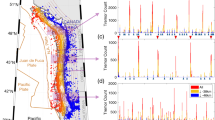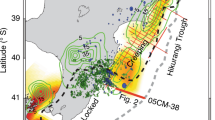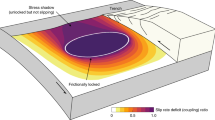Abstract
The slip rate along a fault controls the accumulation of strain that is eventually released during an earthquake1. Along a 150-km-long stretch of the North Anatolian fault near Istanbul, Turkey, strain has been building up2 since the last large earthquake in 1766. Estimates of the geodetic slip rates along the main Marmara fault vary widely, ranging between 17 and 27.9 mm yr−1 (refs 2, 3, 4, 5). This slip rate is difficult to quantify because of the lack of satellite observations offshore and the complexity of the submarine fault system that includes the main Marmara fault2,6,7. Here we estimate the right-lateral slip rate on the main Marmara fault using a three-dimensional geomechanical model that incorporates these structural complexities. From our simulations we infer slip rates between 12.8 and 17.8 mm yr−1; our estimates are smaller and more variable than previous results, primarily because of slip partitioning and internal deformation. Our model results reconcile geodetic observations and geological fault slip rates8,9,10, which had been considered conflicting previously. We suggest that the inferred variability in slip rate on the main Marmara fault favours segmented release of seismic moment during consecutive events over the failure of the whole seismic gap in one large earthquake.
This is a preview of subscription content, access via your institution
Access options
Subscribe to this journal
Receive 12 print issues and online access
$259.00 per year
only $21.58 per issue
Buy this article
- Purchase on Springer Link
- Instant access to full article PDF
Prices may be subject to local taxes which are calculated during checkout




Similar content being viewed by others
References
Scholz, C. H. The Mechanics of Earthquakes and Faulting 2nd edn (Cambridge Univ. Press, 2002).
Le Pichon, X. L., Chamot-Rooke, A., Rangin, C. & Şengör, A. M. C. The North Anatolian fault in the Sea of Marmara. J. Geophys. Res. 108, 2179 (2003).
Flerit, F., Armijo, R., King, G. & Meyer, B. The mechanical interaction between the propagating North Anatolian Fault and the back-arc extension in the Aegean. Earth Planet. Sci. Lett. 224, 347–362 (2004).
Meade, B. J. et al. Estimates of seismic potential in the Marmara Sea region from block models of secular deformation constrained by GPS measurements. Bull. Seism. Soc. Am. 92, 208–215 (2002).
Reilinger, R. et al. GPS constraints on continental deformation in the Africa–Arabia–Eurasia continental collision zone and implications for the dynamics of plate interaction. J. Geophys. Res. 111, B05411 (2006).
Laigle, M. et al. A first deep seismic survey in the Sea of Marmara: Deep basins and whole crust architecture and evolution. Earth Planet. Sci. Lett. 270, 168–179 (2008).
Armijo, R., Meyer, B., Navarro, S., King, G. & Barka, A. Asymmetric slip partitioning in the Sea of Marmara pull-apart: A clue to propagation processes of the North Anatolian Fault? Terra Nova 13, 80–86 (2002).
Armijo, R., Meyer, B., Hubert, A. & Barka, A. Westward propagation of the North Anatolian fault into the northern Aegean: Timing and kinematics. Geology 27, 267–270 (1999).
Rockwell, T. K. et al. International Workshop in Comparative Studies of the North Anatolian Fault and the San Andreas Fault 11–12 (2006).
Rockwell, T. et al. in Paleoseismology: Historical and Prehistorical Records of Earthquake Ground Effects for Seismic Hazard Assessment. Vol. 316 (eds Reicherter, K., Michetti, A. M. & Silva, P. G.) 31–54 (Spec. Publs. Geol. Soc., 2009).
Youngs, R. R. & Coppersmith, K. J. Implications of fault slip rates and earthquake recurrence models to probabilistic seismic hazard estimates. Bull. Seism. Soc. Am. 75, 939–964 (2003).
Erdik, M., Demircioglu, M., Sesetyan, K., Durukal, E. & Siyahi, B. Earthquake hazard in Marmara Region, Turkey. Soil Dyn. Earthq. Eng. 24, 605–631 (2004).
Heidbach, O. & Drewes, H. in New Insights in Structural Interpretation and Modelling (ed. Nieuwland, D.) 259–272 (Spec. Publs. Geol. Soc., 2003).
Bécel, A. et al. Moho, crustal architecture and deep deformation under the North Marmara Trough, from the Seismarmara Leg1 offshore-onshore reflection-refraction survey. Tectonophysics 467, 1–21 (2009).
Carton, H. et al. Seismic imaging of the three-dimensional architecture of the Çınarcık Basin along the North Anatolian Fault. J. Geophys. Res. 112, B06101 (2007).
Parke, J. R. et al. Interaction between faulting and sedimentation in the Sea of Marmara, western Turkey. J. Geophys. Res. 107, B11 (2002).
Seeber, L. et al. Uplift and subsidence from oblique slip: The Ganos-Marmara bend of the North Anatolian Transform, Western Turkey. Tectonophysics 391, 239–258 (2004).
Seeber, L. et al. Rapid subsidence and sedimentation from oblique slip near a bend on the North Anatolian transform fault in the Marmara Sea, Turkey. Geology 34, 933–936 (2006).
Yaltırak, C. Late Pleistocene uplift history along the southwestern Marmara Sea determined from raised coastal deposits and global sea-level variations. Mar. Geol. 190, 283–305 (2002).
Yaltırak, C. & Alpar, B. Evolution of the middle strand of North Anatolian Fault and shallow seismic investigation of the southeastern Marmara Sea (Gemlik Bay). Mar. Geol. 190, 307–327 (2002).
McClusky, S. et al. Global positioning system constraints on plate kinematics and dynamics in the eastern Mediterranean and Caucasus. J. Geophys. Res. 105, 5695–5719 (2000).
Ambraseys, N. The seismic activity of the Marmara sea region over the last 2000 years. Bull. Seismol. Soc. Am. 92, 1–18 (2002).
Acknowledgements
We thank A. Bécel, M. Laigle and A. Hirn for providing data for the basement topography and Moho, and A. Hirn, K. Fuchs, F. Wenzel and M. Laigle for suggestions. This work was supported by the CEDIM Project at the University of Karlsruhe and GFZ German Research Centre for Geosciences, by the Heidelberg Academy of Sciences and Humanities and by the Task Force VII ‘Temporal and Spatial Changes of Stress and Strain’ of the International Lithosphere Program.
Author information
Authors and Affiliations
Contributions
The modelling and analysis was carried out by T.H., in consultation with O.H. Both authors wrote the manuscript.
Corresponding authors
Ethics declarations
Competing interests
The authors declare no competing financial interests.
Supplementary information
Supplementary Information
Supplementary Information (PDF 882 kb)
Rights and permissions
About this article
Cite this article
Hergert, T., Heidbach, O. Slip-rate variability and distributed deformation in the Marmara Sea fault system. Nature Geosci 3, 132–135 (2010). https://doi.org/10.1038/ngeo739
Received:
Accepted:
Published:
Issue Date:
DOI: https://doi.org/10.1038/ngeo739
This article is cited by
-
Numerical Modelling of Lithospheric Block-and-Fault Dynamics: What Did We Learn About Large Earthquake Occurrences and Their Frequency?
Surveys in Geophysics (2022)
-
The slip deficit on the North Anatolian Fault (Turkey) in the Marmara Sea: insights from paleoseismicity, seismicity and geodetic data
Mediterranean Geoscience Reviews (2021)
-
Active fault segments along the North Anatolian Fault system in the Sea of Marmara: implication for seismic hazard
Mediterranean Geoscience Reviews (2021)
-
A review of 20 years (1999–2019) of Turkish–French collaboration in marine geoscience research in the Sea of Marmara
Mediterranean Geoscience Reviews (2021)
-
New trenching results along the İznik segment of the central strand of the North Anatolian Fault (Turkey): an integration with preexisting data
Mediterranean Geoscience Reviews (2021)



